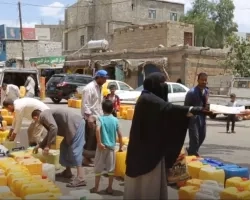In addition to the Missouri Botanical Garden, the St. Louis area is home to some more unusual plant spaces known as ozone gardens, a project started by researchers at Saint Louis University’s Center for Environmental Sciences.
Ozone gardens are comprised of ozone-sensitive plants that noticeably respond to high concentrations of the harmful gas (generally 40 parts per billion or higher). Increasingly, these gardens are being used as a tool to make the public aware of the harmful effects of ozone pollution on plant life, agriculture and ourselves. NASA satellite data helped to show where ozone concentrations are highest, even in parts of the country that might not expect those levels of pollution.
Ozone is a highly reactive gas that can be broadly divided into two categories – “good” and “bad.” Found in the stratosphere, good ozone shields Earth from harmful levels of ultraviolet radiation, while bad ozone is created near the ground from various natural and human sources.
Ground-level ozone can cause or aggravate human health ailments ranging from reduced lung function to severe asthma and emphysema. It can also damage vegetation when plants absorb ozone through their leaves. In some plants, this appears as dark spots on the leaves.
Saint Louis University professor Jack Fishman realized the potential of this visual representation of dangerous ozone when he spearheaded the St. Louis Ozone Garden Project in 2012. Fishman is also a member of the NASA Air Quality Applied Sciences Team (AQAST), which is now known as HAQAST.
The idea for this project sprouted from the Global Ozone (GO3) Project, in which students around the world measured ground-level ozone and uploaded their measurements to a database. Fishman’s idea to start a network of ozone gardens stemmed from his previous work with NASA’s Langley Research Center and the Global Learning through Observations to Better the Environment (GLOBE) Project. He paired living ozone garden exhibits with GO3’s monitoring capabilities, and through cooperation from the Missouri Botanical Garden, the St. Louis Science Center, and Penn State Emeritus Professor John Skelley, he established the St. Louis Ozone Garden Project.
The project’s first goal was to visibly demonstrate the impacts of ozone pollution in locations that people might not think of as having air pollution. “Even though air quality has improved in urban areas because of the regulations implemented by the Clean Air Act … non-urban ozone concentrations in the background atmosphere, where most of the planet’s crops are grown, have increased considerably,” Fishman noted. “The urban vs. nonurban paradox in ozone trends is a key aspect of [our NASA project], which used satellite-derived ozone measurements to show that damage to the U.S. soybean crop resulted in billions of dollars in lost revenue to the country’s farmers.”
The second goal was to create a network of ozone gardens across the country to increase the public’s awareness of air pollution. Project manager Kelley Belina worked with other AQAST members to start ozone gardens across the United States.
“Through presentations at the AQAST Science Team meetings, we were able to make contacts and enlist them to help start gardens at their home institutions,” Belina explained. “In many cases, we sent them seeds or seedlings that they could plant to start their gardens.”
“The urban vs. nonurban paradox in ozone trends is a key aspect of [our NASA project], which used satellite-derived ozone measurements to show that damage to the U.S. soybean crop resulted in billions of dollars in lost revenue to the country’s farmers.”
–Jack Fishman, Saint Louis University and NASA Air Quality Applied Sciences Team
In 2014, the project shipped ozone-sensitive plants from St. Louis to Philadelphia’s Franklin Institute, Loyola University in Chicago, and high schools in Texas and New Hampshire. AQAST members also started two ozone gardens in Colorado, and there are ozone gardens at NASA’s Goddard Space Flight Center and at the Virginia Living Museum in Newport News.
By June 2016, the project went international – with a faculty member at the University of Sheffield starting an ozone garden in England. Across the pond, they call it an air pollution garden. “Nearly any location in the Northern Hemisphere’s middle latitudes is a good one to visualize how ozone damages certain plants,” Fishman added.
One thing his project didn’t take into account? An ozone garden’s vulnerability to other kinds of threats. Fishman remarked, “We learned that the plants were susceptible to natural pests such as insects and rabbits. There was nothing in the field guide about that!”
In the fall of 2016, AQAST expanded to become the Health and Air Quality Applied Sciences Team (HAQAST).
This story is part of our Space for U.S. collection. To learn how NASA data are being used in your state, please visit nasa.gov/spaceforus.




